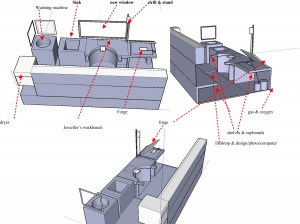It may seem odd, but it was getting our puppy Theo that was the catalyst for working on the studio. New puppy = new fence = meeting a good builder. This is significant as nobody in our house is capable of changing a light bulb let alone doing DIY!
While talking fencing I dropped the bombshell “…would you mind taking a look at the laundry?” The response to “do you think I could squeeze a bench in” was “why not knock out a wall and have one big room?” My making the decision to go ahead, after seven years, came down to the job being so simple…for a builder! This was in June last year, just before a trip to Europe, hence the fence for the dog.
Building was due to start late August. I put down my ideas on paper, a plan. I discovered Bench Exchange in The Ganoksin project, a fantastic website and that gave me enough ideas to attempt a Google Sketch Up draft drawing. And here it is, my wishful thinking:
I studied AutoCAD for two years but I had to go to the Furniture Department because it wasn’t considered part of Jewellery. I never got it. Just too mathematical for me, way over my head. That was in London in 2000. In Melbourne I attended a Digital Workbench workshop (great name) introducing Rhino and I had my first taste of CAD/CAM in 2002. The current prospect of getting my tools out again and fiddling with Sketch Up reignited my interest in CAD.
Do you think anyone teaches it in Victoria? Nope, the best I can find is a unit in an Architecture Course. To learn as a private student is just too costly, let alone the price of the software. I thought it would have been a major part of jewellery design in this Century and as such would be taught as a basic design tool. Maybe it is, just not where I live! Online I’ve been looking at Matrix, JewelCad, 3 Design, Rhino and MOI. All this led me to the Jewellery Fair in Brisbane to see them in action and talk with some company reps.
With a couple of hefty edits to finish, I have to leave my research for now but MOI looks really promising and I’m looking forward to trying it out.
Latest posts by Suzanne (see all)
- Steep Learning Curve - January 29, 2012
- - January 17, 2012
- Mixing Things Up - January 10, 2012


 The Laundry Collection
The Laundry Collection YouTube Channel
YouTube Channel
{ 4 comments… read them below or add one }
Hi Mike,
I’m a step ahead of you…The book you mentioned has pride of place in my office and I flick through it often, thank you Orchid Press. The forge is a throw back to University where I did a lot of Silversmith work. Basically it was a bigger space for bigger items. You are right; the finer jewellery work was dealt with at the bench. My main reason for a slightly separate forge is safety. I wanted to fireproof a corner so that if I’m having a bad day I don’t burn the house down!
The above diagram is deceptive as the distance between bench and forge isn’t far. It will be a continuous piece of wood from the sink to the corner.
The good news is that the door into “The Laundry” is at the laundry end so hopefully my workspace will be my own. I say hopefully because my children are taking an active interest in all this, which is fantastic but also one of the reasons there are two sides/benches in the studio.
Your advice is appreciated, thank you.
If I didn’t have so much $ invested in Rhino I’d probably use MOI. Very similar look and feel but rather different prices. ( same original author)
I use Rhino for almost all design work, fine jewellery to major house renovations. Really fun to learn 🙂 I’m still at it after 7+ years and keep learning new stuff.
jeffD
Hi Suzanne,
The organization of any work bench/ work area is dependent on any number of thing, the most important of which is the desire of the jeweler. I highly recommend that you pick up a copy of The Jewelers Bench Book by Charles Lewton- Brain. This book has ooddles of great storage and organizational info. I notice that your forge/ hot work area is right next to your bench . I prefer my hot work area set up slightly closer so I merely turn my chair to solder or anneal. I also see that the laundry is at the end of the room. Does this mean you’ll have to walk through your jewelry space to do laundry? I’d put the laundry closer to the door to the room in order to leave my workspace at the end of the room undisturbed.
cheers,
Mike
My dad uses Matrix at work, and speaks very highly of it. The downside with any of these packages is that if you are teaching yourself to use them, instead of a full-time training course, you really have to have a wax mill to test your designs – we worked out how much it would have cost us over 6 months to have someone else do the milling for us, including all the test pieces and mistakes we made – £12,000. I sh*t you not.
Although I don’t do the designs myself, I look after the mill, and there really is a lot more to designing than making the shape you want on the screen and then milling it – you have to think not only about the structural integrity of the finished jewellery, but also the structural intregrity of the wax as it is being milled. The type of wax used makes a huge difference, too – we prefer a product called Jewelwax, because you can do very delicate support struts, which you can’t do with the green stuff that Gemvision originally supplied us with.